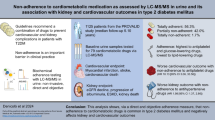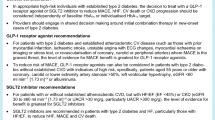Abstract
Introduction
Higher glycated hemoglobin (Hb) (HbA1c) is significantly associated with an increased risk of cardiovascular disease (CVD). Serum uric acid (SUA) levels are associated with glucose intolerance and type 2 diabetes. Whether gender-specific differences regarding the relationship between SUA levels and HbA1c exist is unknown.
Aim
We recruited 1636 (men, 696 aged of 70 ± 10 years; women, 940 aged of 70 ± 9 years) participants and enrolled in the study during their annual health examination from a single community. We investigated the association between SUA levels and HbA1c within each gender.
Results
Multiple linear regression analysis showed that in men, SUA (β = −0.091, p = 0.014) with prevalence of antidiabetic medication (β = 0.428, p < 0.001) and eGFR (β = 0.112, p = 0.016) were significantly and negatively associated with HbA1c, and in women, SUA (β = 0.101, p = 0.002) with prevalence of antidiabetic medication (β = 0.458, p < 0.001) were significantly and positively associated with HbA1c. Moreover, the interaction between gender and SUA (β = 0.445, p < 0.001) as well as gender (β = −0.465, p < 0.001), prevalence of antidiabetic medication (β = 0.444, p < 0.001), eGFRCKDEPI (β = 0.074, p = 0.014), and SUA (β = −0.356, p < 0.001) was a significant and independent determinant of HbA1c. A significant interactive effect of gender and SUA on determinants of HbA1c was noted in patients not on antidiabetic medications, regardless of age, HbA1c, and renal function.
Conclusions
The interaction between gender and SUA was associated with HbA1c independent of other metabolic factors in community-dwelling persons.

Similar content being viewed by others
References
Bash LD, Selvin E, Steffes M, Coresh J, Astor BC (2008) Poor glycemic control in diabetes and the risk of incident chronic kidney disease even in the absence of albuminuria and retinopathy: atherosclerosis risk in communities (ARIC) study. Arch Intern Med 168:2440–2447
Wadén J, Forsblom C, Thorn LM, Gordin D, Saraheimo M, Groop PH (2009) A1C variability predicts incident cardiovascular events, microalbuminuria, and overt diabetic nephropathy in patients with type 1 diabetes. Diabetes 58:2649–2655
Selvin E, Marinopoulos S, Berkenblit G, Rami T, Brancati FL, Powe NR, Golden SH (2004) Meta-analysis: glycosylated hemoglobin and cardiovascular disease in diabetes mellitus. Ann Intern Med 141:421–431
Khaw KT, Wareham N, Bingham S, Luben R, Welch A, Day N (2004) Association of hemoglobin A1c with cardiovascular disease and mortality in adults: the European prospective investigation into cancer in Norfolk. Ann Intern Med 141:413–420
Selvin E, Steffes MW, Zhu H, Matsushita K, Wagenknecht L, Pankow J, Coresh J, Brancati FL (2010) Glycated hemoglobin, diabetes, and cardiovascular risk in nondiabetic adults. N Engl J Med 362:800–811
Hernandez D, Espejo-Gil A, Bernal-Lopez MR, Mancera-Romero J, Baca-Osorio AJ, Tinahones FJ, Armas-Padron AM, Ruiz-Esteban P, Torres A, Gomez-Huelgas R (2016) Association of HbA1c and cardiovascular and renal disease in an adult Mediterranean population. BMC Nephrol 14:151
Rhee JJ, Zheng Y, Montez-Rath ME, Chang TI, Winkelmayer WC (2017) Associations of glycemic control with cardiovascular outcomes among US hemodialysis patients with diabetes mellitus. J Am Heart Assoc 6:e005581
Qiu Q, Gong Y, Liu X, Dou L, Wang Y, Wang B, Liang J (2015) Serum uric acid and impaired glucose tolerance: the cardiometabolic risk in chinese (CRC) study. Cell Biochem Biophys 73:155–162
Lin KC, Tsai ST, Lin HY, Chou P (2004) Different progressions of hyperglycemia and diabetes among hyperuricemic men and women in the kinmen study. J Rheumatol 31:1159–1165
Sluijs I, Beulens JWJ, der Van ADL, Spijkerman AMW, Schulze MB, Van Der Schouw YT (2013) Plasma uric acid is associated with increased risk of type 2 diabetes independent of diet and metabolic risk factors. J Nutr 143:80–85
Ito H, Abe M, Mifune M, Oshikiri K, Antoku S, Takeuchi Y, Togane M (2011) Hyperuricemia is independently associated with coronary heart disease and renal dysfunction in patients with type 2 diabetes mellitus. PLoS One 6:e27817
Juraschek SP, Tunstall-Pedoe H, Woodward M (2014) Serum uric acid and the risk of mortality during 23 years follow-up in the Scottish Heart Health Extended Cohort Study. Atherosclerosis 233:623–629
Kodama S, Saito K, Yachi Y, Asumi M, Sugawara A, Totsuka K, Saito A, Sone H (2009) Association between serum uric acid and development of type 2 diabetes. Diabetes Care 32:1737–1742
Kim SY, Guevara JP, Kim KM, Choi HK, Heitjan DF, Albert DA (2010) Hyperuricemia and coronary heart disease: a systematic review and meta-analysis. Arthritis Care Res (Hoboken) 62:170–180
Borghi C, Rosei EA, Bardin T, Dawson J, Dominiczak A, Kielstein JT, Manolis AJ, Perez-Ruiz F, Mancia G (2015) Serum uric acid and the risk of cardiovascular and renal disease. J Hypertens 33:1729–1741
Taniguchi Y, Hayashi T, Tsumura K, Endo G, Fujii S, Okada K (2001) Serum uric acid and the risk for hypertension and type 2 diabetes in Japanese men: the Osaka Health Survey. J Hypertens 19:1209–1215
Culleton BF, Larson MG, Kannel WB, Levy D (1999) Serum uric acid and risk for cardiovascular disease and death: the Framingham Heart Study. Ann Intern Med 131:7–13
Moriarity JT, Folsom AR, Iribarren C, Nieto FJ, Rosamond WD (2000) Serum uric acid and risk of coronary heart disease: atherosclerosis Risk in Communities (ARIC) Study. Ann Epidemiol 10:136–143
Kawamoto R, Tabara Y, Kohara K, Kusunoki T, Abe M, Miki T (2013) Serum uric acid is more strongly associated with impaired fasting glucose in women than in men from a community-dwelling population. PLoS One 8:e65886
Kawamoto R, Tomita H, Oka Y, Ohtsuka N (2006) Relationship between serum uric acid concentration, metabolic syndrome and carotid atherosclerosis. Intern Med 45:605–614
Meisinger C, Döring A, Stöckl D, Thorand B, Kowall B, Rathmann W (2012) Uric acid is more strongly associated with impaired glucose regulation in women than in men from the general population: the KORA F4-study. PLoS One 7:e37180
Kawamoto R, Ninomiya D, Kasai Y, Kusunoki T, Ohtsuka N, Kumagi T, Abe M (2016) Serum uric acid is positively associated with handgrip strength among japanese community-dwelling elderly women. PLoS One 11:e0151044
Horio M, Imai E, Yasuda Y, Watanabe T, Matsuo S (2010) Modification of the CKD epidemiology collaboration (CKD-EPI) equation for Japanese: accuracy and use for population estimates. Am J Kidney Dis 56:32–38
Kawamoto R, Tabara Y, Kohara K, Kusunoki T, Abe M, Miki T (2013) Synergistic influence of age and serum uric acid on blood pressure among community-dwelling Japanese women. Hypertens Res 36:634–638
Choi HK, Ford ES (2008) Haemoglobin A1c, fasting glucose, serum C-peptide and insulin resistance in relation to serum uric acid levels–the Third National Health and Nutrition Examination Survey. Rheumatology (Oxford) 47:713–717
Wei F, Chang B, Yang X, Wang Y, Chen L, Li WD (2016) Serum uric acid levels were dynamically coupled with hemoglobin A1c in the development of type 2 diabetes. Sci Rep 6:28549
Chien KL, Chen MF, Hsu HC, Chang WT, Su TC, Lee YT, Hu FB (2008) Plasma uric acid and the risk of type 2 diabetes in a Chinese community. Clin Chem 54:310–316
Gill A, Kukreja S, Malhotra N, Chhabra N (2013) Correlation of the serum insulin and the serum uric acid levels with the glycated haemoglobin levels in the patients of type 2 diabetes mellitus. J Clin Diagn Res 7:1295–1297
Cui Y, Bu H, Ma X, Zhao S, Li X, Lu S (2016) The relation between serum uric acid and HbA1c is dependent upon hyperinsulinemia in patients with newly diagnosed type 2 diabetes mellitus. J Diabetes Res 2016:7184123
Gordon T, Kannel WB (1983) Drinking and its relation to smoking, BP, blood lipids, and uric acid. The Framingham study. Arch Intern Med 143:1366–1374
Savage PJ, Pressel SL, Curb JD, Schron EB, Applegate WB, Black HR, Cohen J, Davis BR, Frost P, Smith W, Gonzalez N, Guthrie GP, Oberman A, Rutan G, Probstfield JL, Stamler J (1998) Influence of long-term, low-dose, diuretic-based, antihypertensive therapy on glucose, lipid, uric acid, and potassium levels in older men and women with isolated systolic hypertension: the Systolic Hypertension in the Elderly Program. SHEP Cooperative Research Group. Arch Intern Med 158:741–751
Nicholls A, Snaith ML, Scott JT (1973) Effect of oestrogen therapy on plasma and urinary levels of uric acid. BMJ 1:449–451
Berry CE, Hare JM (2004) Xanthine oxidoreductase and cardiovascular disease: molecular mechanisms and pathophysiological implications. J Physiol 555:589–606
Tabara Y, Kohara K, Kawamoto R, Hiura Y, Nishimura K, Morisaki T, Kokubo Y, Okamura T, Tomoike H, Iwai N, Miki T (2010) Association of four genetic loci with uric acid levels and reduced renal function: the J-SHIPP Suita study. Am J Nephrol 32:279–286
Chiou WK, Wang MH, Huang DH, Chiu HT, Lee YJ, Lin JD (2010) The relationship between serum uric acid level and metabolic syndrome: differences by sex and age in Taiwanese. J Epidemiol 20:219–224
Lippi G, Montagnana M, Franchini M, Favaloro EJ, Targher G (2008) The paradoxical relationship between serum uric acid and cardiovascular disease. Clin Chim Acta 392:1–7
Pasalic D, Marinkovic N, Feher-Turkovic L (2012) Uric acid as one of the important factors in multifactorial disorders–facts and controversies. Biochem Med (Zagreb) 22:63–75
Anker SD, Doehner W, Rauchhaus M, Sharma R, Francis D, Knosalla C, Davos CH, Cicoira M, Shamim W, Kemp M, Segal R, Osterziel KJ, Leyva F, Hetzer R, Ponikowski P, Coats AJ (2003) Uric acid and survival in chronic heart failure: validation and application in metabolic, functional, and hemodynamic staging. Circulation 107:1991–1997
Gersch C, Palii SP, Kim KM, Angerhofer A, Johnson RJ, Henderson GN (2008) Inactivation of nitric oxide by uric acid. Nucleosides Nucleotides Nucleic Acids 27:967–978
Zhi L, Yuzhang Z, Tianliang H, Hisatome I, Yamamoto T, Jidong C (2016) High uric acid induces insulin resistance in cardiomyocytes in vitro and in vivo. PLoS One 11:e0147737
Zhang JX, Zhang YP, Wu QN, Chen B (2015) Uric acid induces oxidative stress via an activation of the renin-angiotensin system in 3T3-L1 adipocytes. Endocrine 48:135–142
Li Q, Yang Z, Lu B, Wen J, Ye Z, Chen L, He M, Tao X, Zhang W, Huang Y, Zhang Z, Qu S, Hu R (2011) Serum uric acid level and its association with metabolic syndrome and carotid atherosclerosis in patients with type 2 diabetes. Cariovasc Diabetol 10:72
Han Nan H, Dong Y, Gao W, Tuomilehto J, Qiao Q (2007) Diabetes associated with a low serum uric acid level in a general Chinese population. Diabetes Res Clin Pract 76:68–74
Nan Hairong, Pang Zengchang, Wang Shaojie, Gao Weiguo, Zhang Lei, Ren Jie, Ning Feng, Tuomilehto J, Qiao Qing (2010) Serum uric acid, plasma glucose and diabetes. Diab Vasc Dis Res 7:40–46
Acknowledgements
This work was supported by a Grant-in-Aid for Scientific Research (C) (2015-2017). No additional external funding was received for this study. The funders had no role in the study design, data collection and analysis, decision to publish, or preparation of the manuscript.
Author information
Authors and Affiliations
Corresponding author
Ethics declarations
Conflict of interest
The authors declare that they have no conflict of interests.
Ethics approval
All procedures performed in studies involving human participants were in accordance with the ethical standards of the institutional research committee at which the studies conducted (IRB Approval Number: 1402009).
Informed consent
Informed consent was obtained from all subjects participating in the study.
Rights and permissions
About this article
Cite this article
Kawamoto, R., Ninomiya, D., Kasai, Y. et al. Interaction between gender and uric acid on hemoglobin A1c in community-dwelling persons. J Endocrinol Invest 41, 421–429 (2018). https://doi.org/10.1007/s40618-017-0760-5
Received:
Accepted:
Published:
Issue Date:
DOI: https://doi.org/10.1007/s40618-017-0760-5




